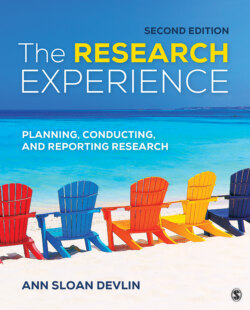Читать книгу The Research Experience - Ann Sloan Devlin - Страница 17
Try This Now 1.1
ОглавлениеBefore you read further, what card(s) did you select?
People usually select E and frequently E in combination with K and 4; they hardly ever select 7.
The Wason Selection Task demonstrates an important part of thinking related to research. Humans have a much easier time thinking of ways to confirm information (think hypothesis) than to disconfirm it. What comes far less easily is taking a disconfirmational strategy to the hypothesis or the theory by seeking to disconfirm it. In research, we seem far more willing to seek to confirm rather than to disconfirm. Humans tend to exhibit what is known as confirmation bias in that we look for information that confirms our hypotheses. We also need to ask ourselves the question, what situation(s) would be a good test to show that the hypothesis is incorrect?
Confirmation bias: Tendency to look for information that confirms our hypotheses.
In the research findings of Kahneman and Tversky, you have seen that our cognitive processes are susceptible to a wide range of influences and biases. Even such respected researchers as Kahneman and Tversky may have been susceptible to the biases they studied. In the article “Voodoo Correlations Are Everywhere—Not Only in Neuroscience,” Klaus Fiedler (2011) showed that the use of the letter K (discussed earlier in this chapter) for Tversky and Kahneman’s (1973) demonstration of the availability heuristic may have used an unrepresentative letter (K). Because this finding has not been replicated with many other letters of the alphabet (as Fiedler reported, citing the work of Sedlmeier et al. [1998]), using K may not have been a good test of Tversky and Kahneman’s hypothesis. In selecting their stimulus (K) intuitively, Fiedler explained, Tversky and Kahneman were fallible human beings: “Such an intuitive selection process will typically favor those stimuli that happen to bring about the expected phenomenon, making mental simulation an omnipresent source of bias in behavioral research” (Fiedler, 2011, p. 165).
In other words, Fiedler (2011) argued that the authors (consciously or otherwise) selected a stimulus that was likely to prove their point. The larger message of this research example provides a cautionary tale: Researchers and cognitive animals want to validate their hypotheses; by reinforcing what the Wason Selection Task shows, they seek to prove, not to disprove, and are likely to select stimuli that support their hypotheses rather than stimuli that challenge or refute them.
How can humans guard against this common “affirming” behavior? Being aware that such errors are likely is the first step. Asking how one might disprove or refute the hypothesis is another step. Imagining the conditions under which a prediction would not hold is as important as identifying the conditions under which the prediction is likely to hold. In other words, ask yourself what evidence would counter the hypothesis.
